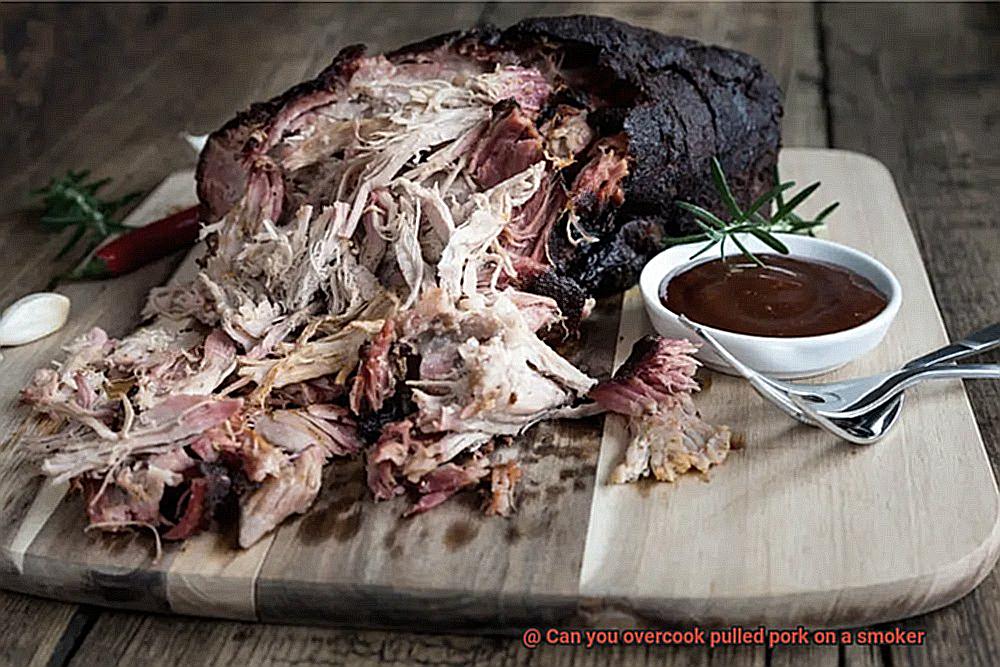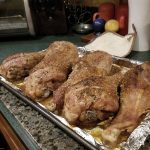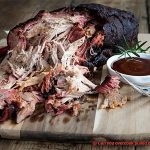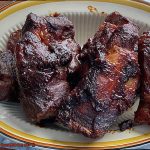Pulled pork is one of those dishes that can make your mouth water just thinking about it. The smoky, savory flavor and tender texture are enough to make anyone’s taste buds sing. But let’s face it, cooking pulled pork on a smoker can be tricky business. One of the biggest fears for any pitmaster is whether they’ve overcooked their pork. So, can you overcook pulled pork on a smoker? It’s not a simple yes or no answer.
To truly understand if you’ve overcooked your pulled pork, you need to know what “overcooked” really means. Some people think it’s dry or tough meat, while others argue that burnt or charred meat is the true sign of overcooking. Regardless, nobody wants to put hours into smoking a pork shoulder only to end up with something inedible.
Don’t worry though, I’ve got your back. In this post, we’ll explore the ins and outs of cooking pulled pork on a smoker and help you determine if you’ve overcooked your meat. We’ll go over the perfect temperature range for cooking pork, signs that indicate you may have overdone it, and even some tips for rescuing an overcooked piece of meat. By the time we’re done here, you’ll be armed with all the knowledge necessary to cook perfect pulled pork every single time.
Contents
What is Pulled Pork?
Pulled pork is a dish that has captured the hearts (and stomachs) of foodies around the world. This Southern classic involves slow-cooking pork until it’s tender enough to be “pulled” apart into small, juicy pieces. Here’s what you need to know about this mouth-watering delicacy.
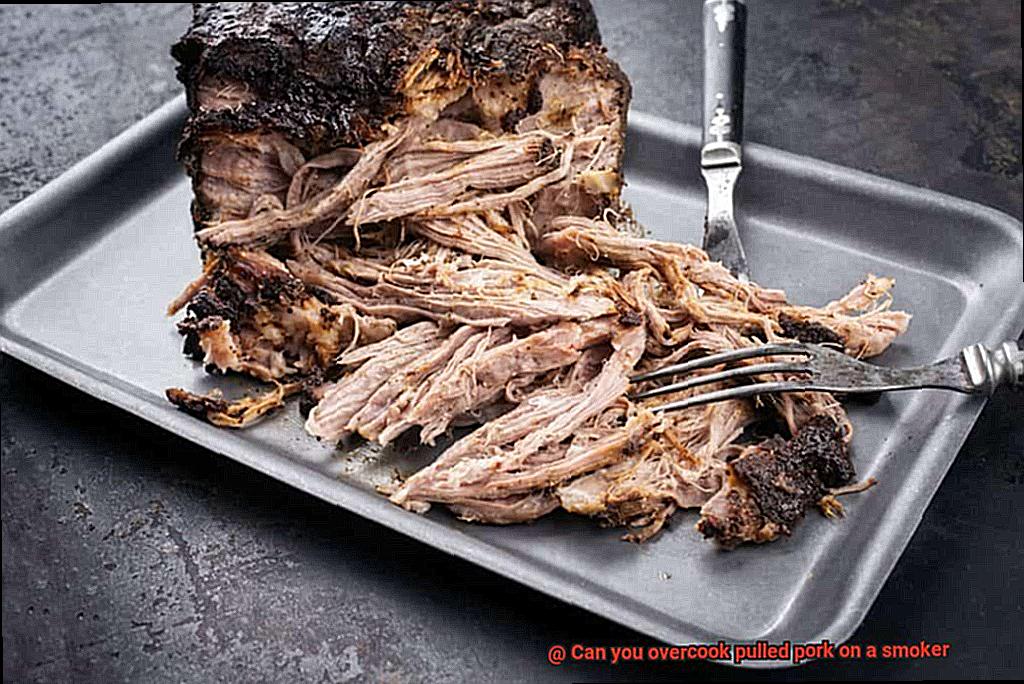
One of the secrets to making great pulled pork is choosing the right cut of meat. Pork shoulder or Boston butt are popular choices because of their high fat content and marbling, which makes them ideal for smoking and slow cooking.
Once you have your meat, it’s time to season it with a dry rub or marinade and then smoke it at low temperatures for several hours. The goal is to get the internal temperature of the pork between 195-205°F, which will allow the fat to melt and the connective tissues to break down, resulting in moist, flavorful meat that falls apart easily.
To avoid overcooking, it’s crucial to monitor the internal temperature of the meat using a meat thermometer. And if you want to retain moisture and prevent excessive smoke absorption, consider using foil wraps or aluminum pans during the cooking process.
When the meat is cooked perfectly, it’s time to let it rest for at least 30 minutes before pulling or chopping it into small pieces. Pulled pork can be served on its own as a main dish or used as a topping for sandwiches, tacos, or salads. And don’t forget to add some barbecue sauce or other condiments to enhance its flavor.
The Dangers of Overcooking Pulled Pork on a Smoker
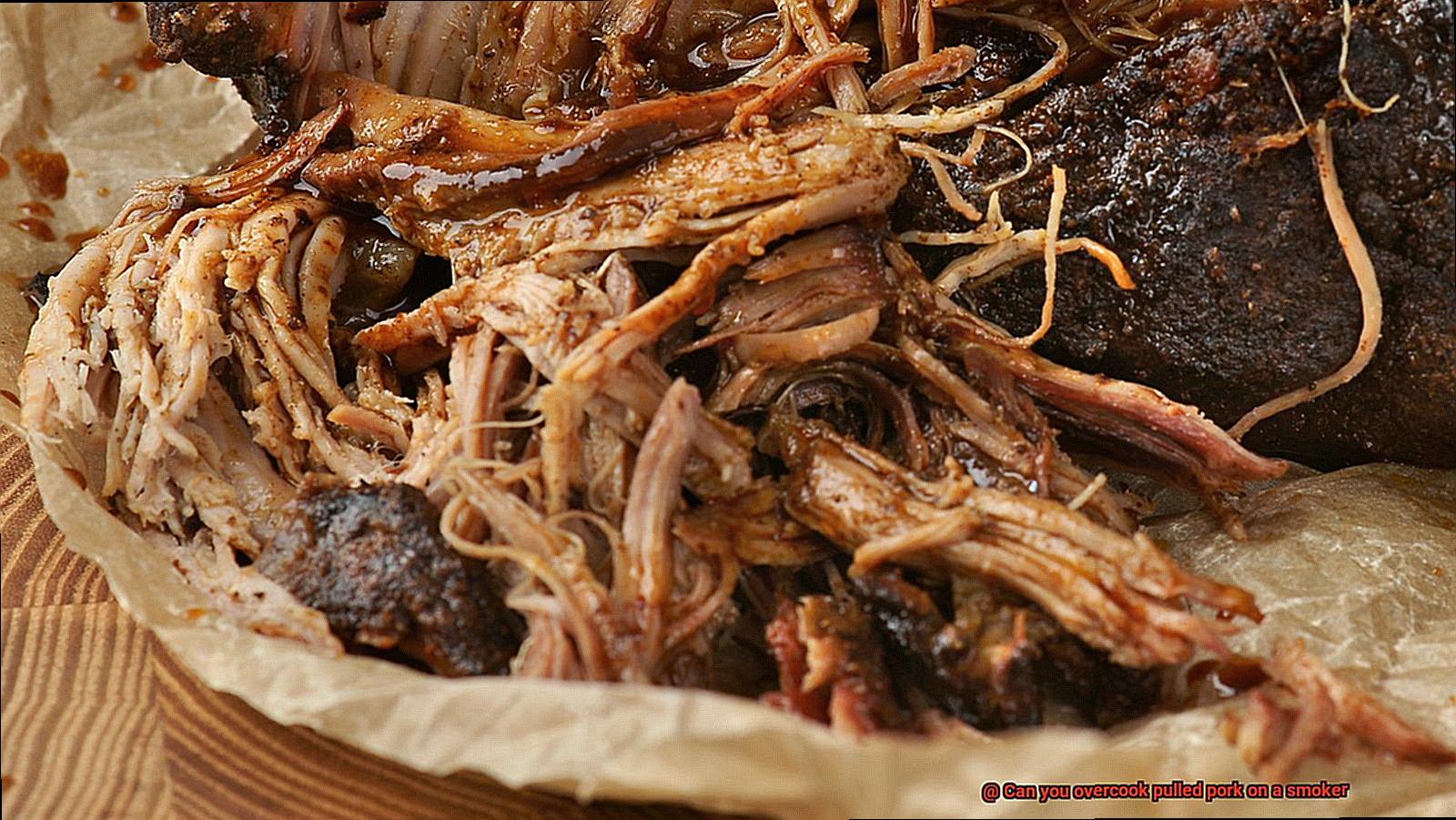
While overcooking may seem like a minor mistake, it can have serious consequences that extend beyond simply ruining your meal.
Perhaps the most obvious danger of overcooking pulled pork is that it can result in dry and tough meat that is anything but appetizing. Instead of the tender and juicy texture that we all crave, you’ll be left with a chewy mess that’s more reminiscent of shoe leather than succulent pork.
But the risks don’t stop there. Another major danger of overcooking pulled pork on a smoker is that it can create the perfect environment for harmful bacteria to grow in the meat. This can occur when the temperature of the meat isn’t high enough to kill off these bacteria during cooking. The longer the meat is exposed to heat, the greater the risk of bacterial growth, which can lead to food poisoning and other illnesses.
Furthermore, overcooking pulled pork can cause a loss of vital nutrients in the meat. The high heat and extended cooking time can break down many essential vitamins and minerals found in pork, resulting in a less healthy meal overall. So not only will your pulled pork lack flavor and texture, but it will also be less nutritious than it could be.
Finally, let’s talk about the wasted time, money, and effort that comes with overcooking pulled pork on a smoker. It’s frustrating to spend hours preparing and cooking a piece of pork only to find out that it’s been ruined due to overcooking. This wasted effort can be avoided by following proper cooking techniques and ensuring that the temperature of the meat is monitored closely throughout the cooking process.
How to Avoid Overcooking Pulled Pork on a Smoker
Smoking pulled pork on a smoker can be a thrilling experience, but overcooking can be a common and costly mistake. Overcooked and dry pulled pork lacks flavor and texture, making it a waste of time and effort. However, avoiding overcooking is not rocket science and can be achieved with a few simple tips that guarantee a delicious and juicy final product every time.
Choose the Right Cut of Meat
Choosing the right cut of meat is crucial to avoid overcooking. A pork shoulder or Boston butt is the best cut for smoking as it has a higher fat content that helps keep the meat moist during cooking. It is also recommended to choose a piece of meat that is around 8-10 pounds in weight, as larger cuts tend to cook more evenly and retain moisture better.
Monitor the Temperature
Monitoring the temperature of the smoker and the internal temperature of the meat is crucial to avoid overcooking pulled pork. The ideal temperature range for smoking pork is between 225-250°F. Investing in a good quality thermometer will help ensure that the temperature remains consistent throughout the cooking process. Checking the internal temperature of the meat every hour once it has been cooking for a few hours will help you stay on top of your cooking game.
Wrap in Foil or Butcher Paper
Wrapping the pork in foil or butcher paper once it reaches an internal temperature of around 160°F can help prevent overcooking and retain moisture. This technique, known as the Texas Crutch, helps create a steaming effect that keeps the meat moist while also speeding up the cooking process.
Properly Prepare the Meat
Properly preparing the meat before smoking can also help avoid overcooking. Trimming any excess fat from the pork shoulder is essential as this can cause flare-ups that may lead to uneven cooking. Additionally, allowing the pork shoulder to come to room temperature before placing it in the smoker can help ensure even cooking.
Let it Rest
Allowing the meat to rest after cooking is essential to avoid overcooking. Letting the pulled pork rest for at least 30 minutes before shredding allows the juices to redistribute throughout the meat, resulting in a moist and tender final product.
Monitoring Internal Temperature of the Meat
If you’re a pulled pork smoking aficionado, you know that the key to success lies in monitoring the internal temperature of your meat. Achieving a consistent temperature throughout the cooking process is vital to ensure that your meat is not only safe to eat but also tastes delicious.
While this is essential for all types of meat, it’s particularly crucial when it comes to pork. Undercooking it can lead to food poisoning, while overcooking it can result in dry, tough meat. But don’t worry; we’ve got you covered with some tips and tricks to make sure your smoked pulled pork is perfection on a plate.
First and foremost, invest in a digital meat thermometer. This tool will be your best friend throughout the cooking process. Insert the thermometer into the thickest part of the meat, making sure that it doesn’t touch any bone. Leave it in place during the cooking process and check periodically.
But knowing the temperature isn’t enough; you must also be aware of the “stall.” This refers to a period during cooking when the internal temperature of the meat plateaus or even drops slightly before continuing to rise. Don’t panic during this period and avoid increasing the heat or opening the smoker’s lid. Doing so can result in uneven cooking or even dried-out meat.
When monitoring your smoked pulled pork’s internal temperature, aim for a range of 195-205°F for optimal results. However, note that this range may vary depending on factors such as humidity, altitude, and even the type of smoker being used.
To recap, here are some essential points to keep in mind when monitoring the internal temperature of your smoked pulled pork:
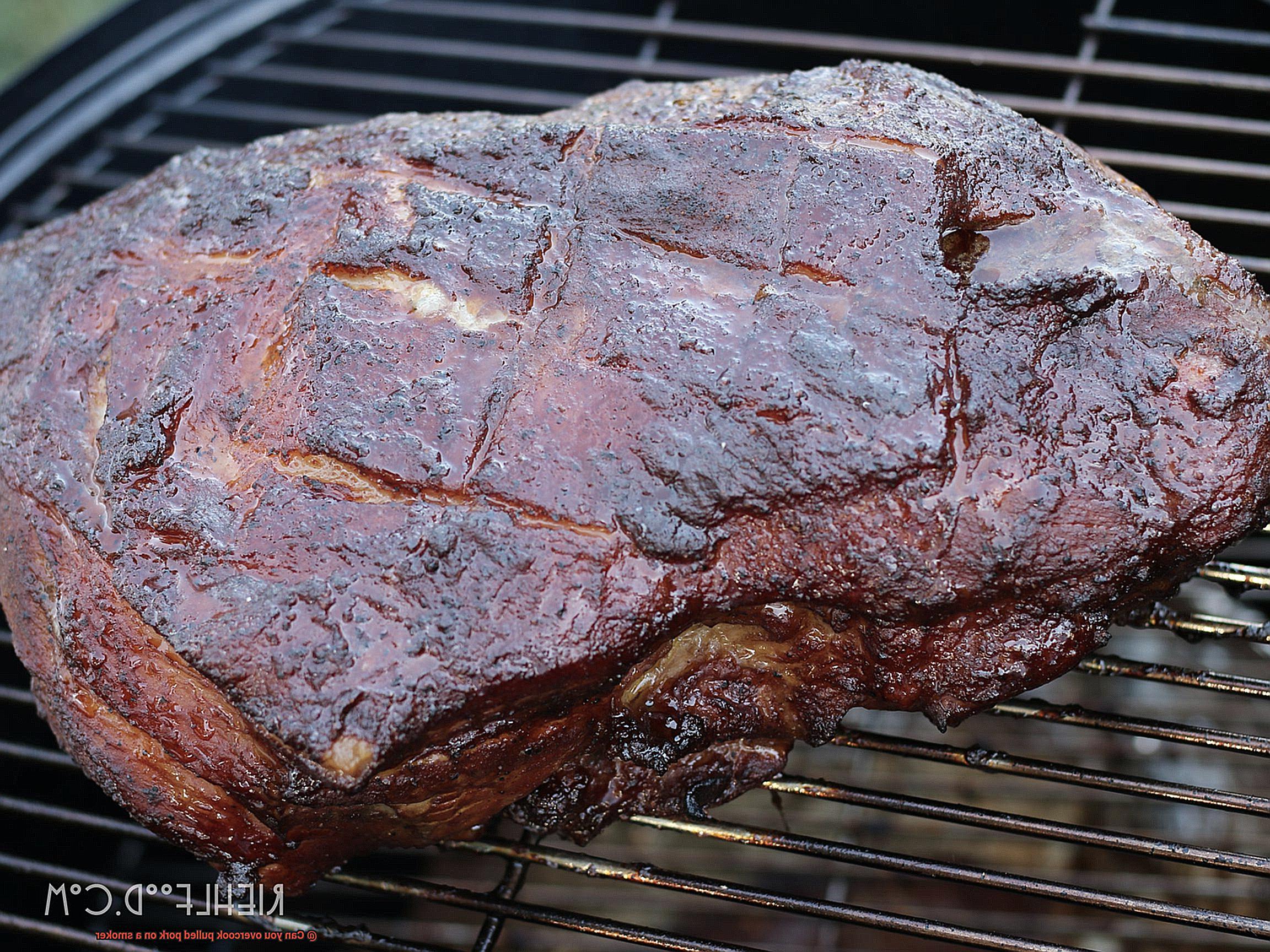
- Use a digital meat thermometer
- Check periodically for temperature
- Be aware of the stall and avoid panicking
- Aim for an internal temperature between 195-205°F
Using Foil Wraps or Pans to Retain Moisture and Control Smoke Absorption
One such technique is using foil wraps or pans to retain moisture and control smoke absorption. These methods can make a huge difference in the quality of your smoked pulled pork.
Foil wraps are a great option to retain moisture during the smoking process. By wrapping the pork tightly, you can ensure that it won’t dry out while still allowing the smoke flavor to penetrate the meat. The foil wrap should be sealed tightly around the pork to prevent any steam from escaping which would result in dry meat. However, it’s essential not to leave the meat wrapped for too long, as overcooking can still occur.
Another great option is using a foil pan to hold the pulled pork. This method not only retains moisture but also allows for easy transportation and serving. Just make sure to cover the pan tightly with foil to prevent smoke from escaping. A foil pan can also be used to separate different meat cuts during smoking.
But as with any technique, there are drawbacks to consider. Leaving the meat in a foil wrap or pan for too long can result in dry and tough pulled pork. And while these methods can control smoke absorption, they also limit the development of a bark on the meat.
Using Quality Cuts of Meat and Proper Seasonings and Marinades
Well, the secret to achieving such delectable goodness lies in using quality cuts of meat and proper seasoning and marinades. As an expert in this field, I can assure you that investing in a good quality Boston butt is essential to making the perfect pulled pork. This cut comes from the upper part of the pig’s front shoulder and contains a good amount of fat, which keeps the meat moist during the long smoking process.
But wait, there’s more to it than just the cut of meat. To ensure that your pulled pork is packed with flavor, a generous application of dry rub is critical. A mix of salt, sugar, paprika, garlic powder, and cumin can work wonders for your taste buds. To allow the flavors to penetrate deeply, let the meat sit for at least an hour before smoking.
And if you’re feeling adventurous, why not try marinating your meat before smoking? Adding an acid such as vinegar or citrus juice along with herbs and spices can add another dimension to the flavor profile while also tenderizing the meat. But be careful not to overdo it – too much acid can lead to a mushy texture.
Now that you’ve got the basics down, it’s time to fire up that smoker. Use foil wraps or pans to retain moisture and control smoke absorption. However, be sure not to leave your pork wrapped up for too long as it may overcook.
rgPJxy_IngY” >
Conclusion
In conclusion, pulled pork is a delectable dish that requires careful attention and preparation when cooking on a smoker. Overcooking can be a common mistake, resulting in dry, tough meat that lacks flavor and nutritional value. Wasted time and effort are also unfortunate consequences of overcooked pulled pork.
To avoid overcooking, it’s crucial to choose the right cut of meat, prepare it properly before smoking, monitor the temperature using a digital meat thermometer, and wrap it in foil or butcher paper to retain moisture and control smoke absorption. These steps ensure that your pulled pork is cooked to perfection every time.
Monitoring the internal temperature of the meat is particularly important for achieving optimal results. Using foil wraps or pans to retain moisture and control smoke absorption is another useful technique that can make a significant difference in the quality of your smoked pulled pork. And finally, using quality cuts of meat and proper seasoning and marinades are essential for achieving mouth-watering goodness.
So, fire up that smoker with confidence. Armed with these tips and tricks, you’ll be able to impress your friends and family with perfectly cooked pulled pork every single time.

